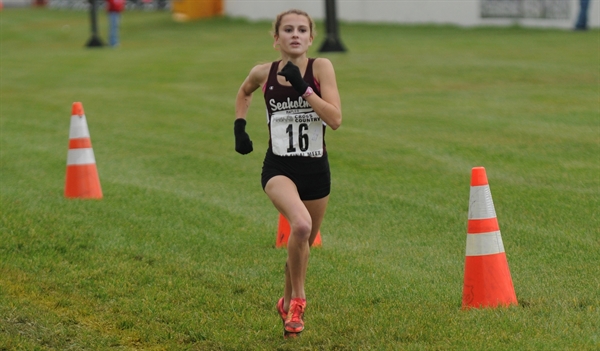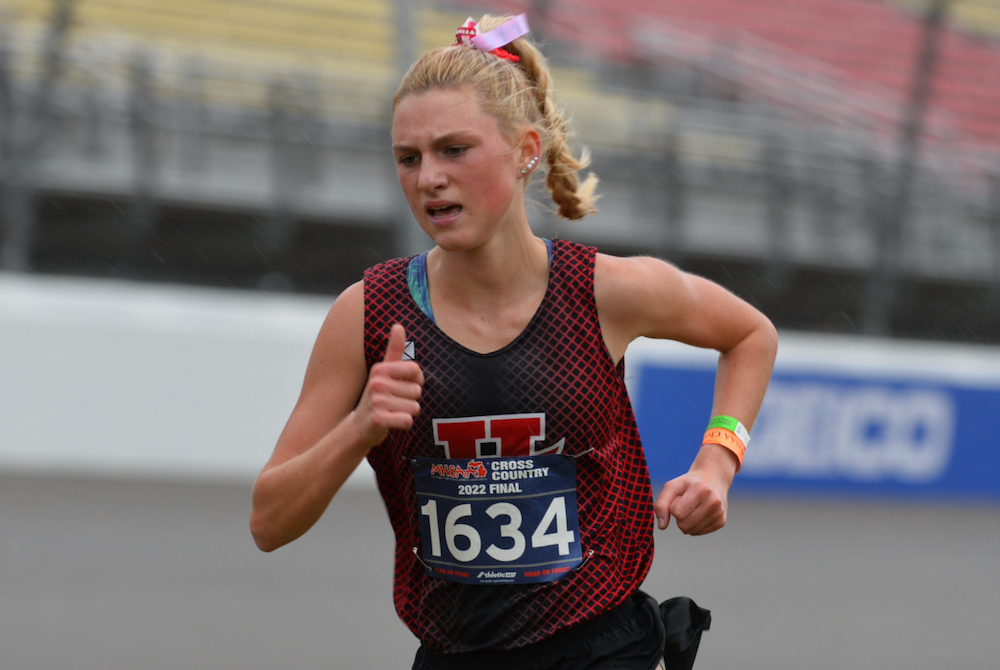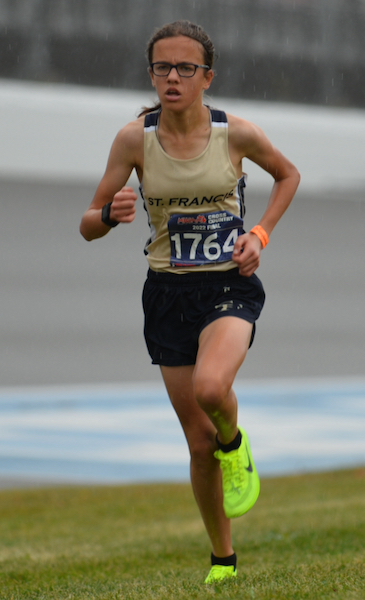
Seaholm Star Tunes Out Hype, Fulfills It
November 2, 2013
By Bill Khan
Special to Second Half
BROOKLYN — Audrey Belf tuned out all of the noise.
The Birmingham Seaholm junior didn't want to get caught up in all of the chatter surrounding her quest to win the MHSAA Division 1 cross country championship. She didn't want to read the comparisons between her and former Rochester runner Megan Goethals, who holds the MHSAA finals record and is now an All-American at the University of Washington.
Belf wanted to relax her mind all week, then do what she does best — race hard.
"I never had that much pressure in my life," Belf said. "I kind of stopped using the Internet for a week. I didn't want to see anything or have any reason to psyche myself out. I wanted to go into the race with a clear head."
The nationally ranked Belf fulfilled expectations on Saturday by winning the Division 1 championship in a time of 17:31.1. Rockford senior Lauren Brasure stayed close enough to keep the issue in doubt, finishing second in 17:40.8.
"She's a great runner and definitely pushes me," Belf said. "I knew it would be a close race. We both ran great."
Belf admitted that she had her sights on the MHSAA finals record of 16:54.8 set by Goethals in 2009. Achieving that time became more difficult when rains soaked the MIS course right up until race morning, creating a sloppy mess in some spots.
"It was a little muddy," Belf said. "Coming into the stadium, I was on pace for my goal time. When I got into the stadium, it slowed me up a little bit. You can't do anything about it. It's OK. I'm happy about it."
Belf made a huge jump from 33rd place last year in 18:32.8 to MHSAA champion.
"I was a little bit sick and had a bad day (in 2012)," Belf said. "This summer and last spring, I worked on raising my confidence going into races. It really helped me this year."
Brasure lost only three races all season — all to Belf.
The only downer for Belf was that her Seaholm team didn't repeat as champion. Northville won its first MHSAA finals championship by scoring 107 points. Saline was second with 139, Hudsonville third with 164 and Seaholm fourth with 165. Rockford was fifth with 169 points, cracking the top 10 for the 20th straight year.
Northville had a strong front pack, with its top four runners finishing 10.8 seconds apart in the top 21 among team finishers. Senior Rachel Coleman was 10th in the team race in 18:23.3, sophomore Lexa Barrott was 13th in 18:27.0, senior Taleen Shahrigian was 14th in 18:30.2, freshman Cayla Eckenroth was 21st in 18:34.1 and senior Nicole Mosteller was 49th in 19:10.2.
PHOTO: Birmingham Seaholm’s Audrey Belf takes the final strides toward her first MHSAA cross country championship. (Click to see more from RunMichigan.com).

Jazwinski Brings Hart Individual Title as St. Francis Moves to Front of Team Pack
November 5, 2022
BROOKLYN – Cross country races can be won between the ears before runners ever step foot onto the course.
Attitudes were tested as rain began to descend on Michigan International Speedway and the wind picked up just before the start of the MHSAA Lower Peninsula Division 3 girls race late Saturday morning.
Hart sophomore Jessica Jazwinski was loving life as she prepared to race.
“As a distance runner, I really try to love the wind,” she said. “Distance running and cross country is just a tough sport. The wind just adds to it — and the rain, too. It’s super fun.
“I was just thinking these conditions are just gonna feed my great race. This is real cross country. Yeah!”
Jazwinski overcame the elements to run the fifth-fastest Division 3 time ever, winning with a time of 17:36.70. She has two of the top-five times in Division 3 Finals history, having run 17:31.4 to place third last year.
“Today my race plan was just to go out hard and try to hold on to my pace,” she said. “I feel like I tried to race a lot like Steve Prefontaine, just go out and hold on.”
 Lansing Catholic senior Hannah Pricco was second in 18:17.59, Onsted sophomore Emmry Ross was third in 18:20.96 and Hart junior Alyson Ens was fourth in 18:28.52.
Lansing Catholic senior Hannah Pricco was second in 18:17.59, Onsted sophomore Emmry Ross was third in 18:20.96 and Hart junior Alyson Ens was fourth in 18:28.52.
“I love having great teammates to work with and encourage each other,” Jazwinski said. “We really try to encourage each other so much throughout the races. Throughout this year, some races she’s been a minute behind me, some races she’s been five seconds. I don’t want her to ever beat me, so that pushes me so much. I know she’s trying to race me and get up there with me.”
The only downer for Hart was having its string of Division 3 championships end at five with a fourth-place finish. Hart had two runners in the top four, but its No. 3 runner was 68th.
“I would totally trade my individual title for a team title,” Jazwinski said.
Traverse City St. Francis emerged from a close battle to win its first title since 2016 with 134 points. Pewamo-Westphalia was second with 142 and Lansing Catholic third with 165.
Sophomore Betsy Skendzel led St. Francis, placing seventh in 18:48.33. Completing the team score were senior Sophia Rhein in 26th (19:43.27), sophomore Grace Slocum in 33rd (20:07.95), junior Rylee Duffing in 60th (20:44.82) and junior Margot Hagerty in 63rd (20:45.78).
Lansing Catholic had three place in the top 10, but didn’t get another finisher until 103rd.
PHOTOS (Top) Hart’s Jessica Jazwinski pushes toward the finish during Saturday’s LPD3 Final. (Middle) Traverse City St. Francis’ Betsy Skendzel leads the way for the eventual team champion. (Click for more from Dave McCauley/RunMichigan.com.)

